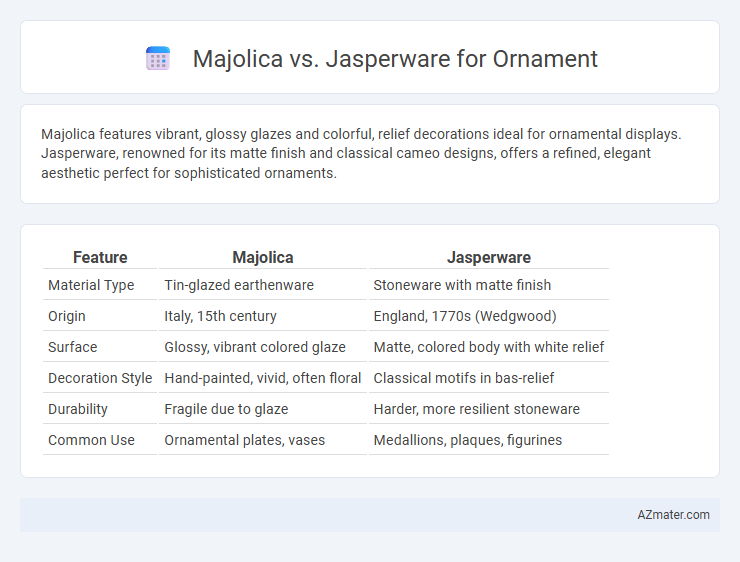Majolica features vibrant, glossy glazes and colorful, relief decorations ideal for ornamental displays. Jasperware, renowned for its matte finish and classical cameo designs, offers a refined, elegant aesthetic perfect for sophisticated ornaments.
Table of Comparison
| Feature | Majolica | Jasperware |
|---|---|---|
| Material Type | Tin-glazed earthenware | Stoneware with matte finish |
| Origin | Italy, 15th century | England, 1770s (Wedgwood) |
| Surface | Glossy, vibrant colored glaze | Matte, colored body with white relief |
| Decoration Style | Hand-painted, vivid, often floral | Classical motifs in bas-relief |
| Durability | Fragile due to glaze | Harder, more resilient stoneware |
| Common Use | Ornamental plates, vases | Medallions, plaques, figurines |
Introduction to Majolica and Jasperware
Majolica is a vibrant, tin-glazed pottery known for its colorful, glossy finish and intricate naturalistic designs, originating in the Renaissance period and prominently produced in Italy and England. Jasperware, developed by Josiah Wedgwood in the 18th century, is characterized by its matte finish and classical relief decorations, often in blue and white, designed to mimic ancient Roman cameos. Both Majolica and Jasperware serve as popular ornamental ceramics, but their distinct glazing techniques and stylistic elements set them apart in decorative art collections.
Historical Origins and Evolution
Majolica, originating in the Renaissance period of 15th-century Italy, features tin-glazed earthenware with vibrant, colorful glazes and intricate hand-painted designs inspired by natural motifs and mythology. Jasperware, developed in the late 18th century by Josiah Wedgwood in England, is distinguished by its matte finish and classical relief decorations in white contrasting against colored backgrounds, symbolizing neoclassical elegance. The evolution of these ceramics reflects shifts in artistic trends and technological advancements, with Majolica embodying Renaissance exuberance and Jasperware representing refined neoclassical aesthetics.
Key Characteristics of Majolica
Majolica is characterized by its vibrant, glossy glaze and richly detailed, three-dimensional designs that often depict natural motifs such as flowers, animals, and foliage. This earthenware features a tin or lead glaze that creates a distinctive bright and colorful surface, distinguishing it from Jasperware's matte and classical relief decorations. Majolica's durability and intricate hand-painted patterns make it a popular choice for ornamental pieces that emphasize texture and lively coloration.
Defining Features of Jasperware
Jasperware is characterized by its matte finish and distinct blue, green, or lilac base colors with white bas-relief decorations, typically depicting classical scenes and motifs. Unlike the glossy, colorful, and often highly glazed surface of Majolica, Jasperware's unglazed stoneware composition gives it a unique, refined texture favored in neoclassical ornamentation. This defining feature makes Jasperware highly collectible and distinguishable in decorative arts, contrasting with Majolica's more vibrant, rustic appeal.
Materials and Manufacturing Techniques
Majolica ornaments are crafted from earthenware clay, glazed with vibrant, lead-based or tin-based glazes that create a glossy, colorful finish through a kiln-firing process. Jasperware, developed by Wedgwood, uses unglazed stoneware with a matte finish, featuring characteristic pale blue or green matte bodies and white bas-relief decorations applied using molds before firing. The manufacturing technique for Majolica emphasizes hand-painting and glazing for vivid coloration, while Jasperware relies on precise molding and relief application for its iconic neoclassical aesthetic.
Color Palettes and Decorative Styles
Majolica ornaments feature vibrant, glossy color palettes dominated by rich blues, greens, yellows, and reds, achieved through tin-glazed earthenware techniques. In contrast, Jasperware ornaments exhibit matte finishes with a limited but elegant color range, primarily soft pastels like pale blue, lilac, and sage green, typically adorned with white bas-relief classical motifs. Decorative styles in Majolica are often naturalistic and exuberant, including floral, animal, and garden themes, while Jasperware favors neoclassical designs inspired by ancient Greek and Roman art, emphasizing symmetry and refined elegance.
Artistic and Cultural Significance
Majolica, with its vibrant, brightly colored glazes and naturalistic motifs, reflects the 19th-century European fascination with nature and exoticism, serving as a testament to the Victorian era's decorative arts. Jasperware, pioneered by Wedgwood in the 18th century, is renowned for its matte finish and neoclassical reliefs, embodying Enlightenment ideals and classical antiquity that influenced European art and culture. Both pottery styles remain culturally significant, with Majolica representing ornamental exuberance and Jasperware symbolizing refined neoclassical taste in collectible decor.
Durability and Maintenance Considerations
Majolica ornaments are less durable due to their porous earthenware composition, requiring careful handling to avoid chips and cracks, while jasperware, made from dense, unglazed stoneware, offers superior durability and resistance to wear. Majolica's vibrant glazes may fade or suffer damage if exposed to harsh cleaning agents, necessitating gentle cleaning, whereas jasperware is low-maintenance, often cleaned with a soft brush or mild soap without risk to its matte finish. For long-term preservation, jasperware is preferred in environments prone to handling or fluctuating conditions, while majolica demands controlled display and care to maintain its decorative appeal.
Popular Uses in Ornamentation
Majolica, renowned for its vibrant, colorful glazes, is frequently used in ornamental ceramics such as vases, plates, and decorative tiles, often featuring naturalistic themes like flowers and animals. Jasperware, a type of unglazed stoneware developed by Wedgwood, is favored for its matte finish and classical motifs, making it ideal for cameo-style relief decorations on plaques, medallions, and urns. Both materials are prized in home decor and collectible ornaments, with Majolica highlighting bold color contrasts and Jasperware emphasizing refined, neoclassical elegance.
Collecting and Valuing Majolica vs. Jasperware
Majolica and Jasperware are distinct collectible ceramics, each valued for unique artistic qualities and historical significance. Majolica's vibrant, colorful glazes and naturalistic designs appeal to collectors seeking visually striking ornaments, often commanding high prices in antique markets due to their rarity and craftsmanship from the Victorian era. Jasperware, developed by Wedgwood, is prized for its matte finish and classical motifs, with its well-documented provenance and subtle elegance making it highly collectible and valuable for those focused on neoclassical decorative arts.

Infographic: Majolica vs Jasperware for Ornament
 azmater.com
azmater.com